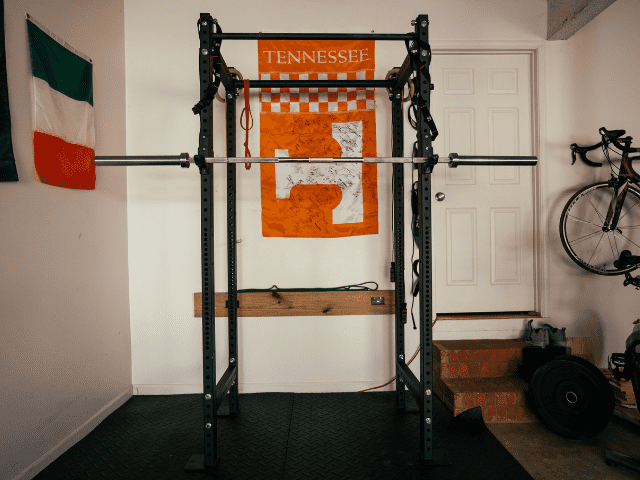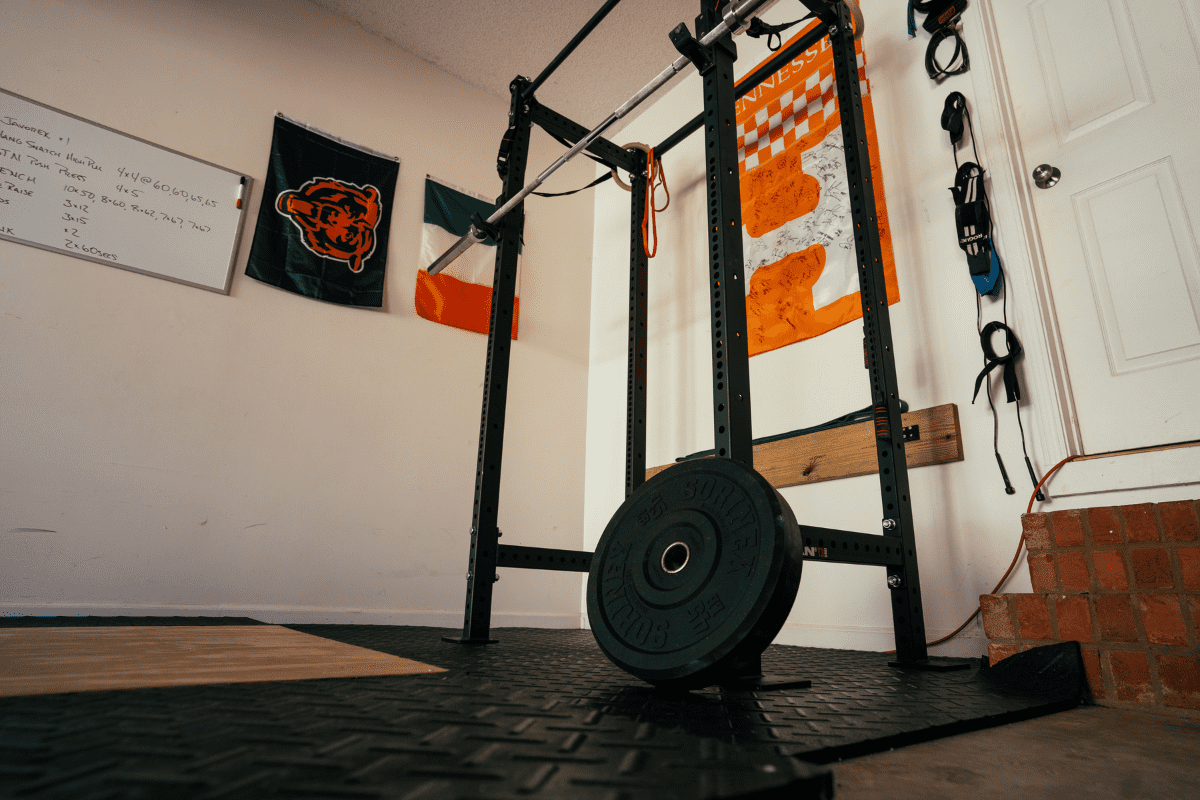Squat Rack Specs Explained (Dimensions, Steel Guage, etc)
When you’re in the market for a new squat rack, chances are you’ll find yourself trying to compare squat rack specs between racks.
But, between steel gauge, hole spacing and 3 x 3s vs 2 x 3s – it’s easy to get frustrated trying to figure out what’s good, what’s bad and what rack is the best fit for your home gym.
In this article I’m going to explain each of following common squat rack specs:
- Dimensions (Height, Width and Depth)
- Weight Capacity
- Upright Size
- Steel Gauge
- Hole Spacing
- Hardware Size
- Bolt Down or Free Standing
- Rack Attachments
I’ll also let you know which specs you should focus on and what size steel gauge is actually good.
Get ready, cause in a few minutes you’re going to be a regular squat rack expert.
Squat Rack Specs
Squat Rack Dimensions (Height, Width, Depth)
Let’s start with the easier specs first – height, width and depth.
The height of the rack is pretty self-explanatory, but here is one thing to keep in mind. The height of your rack should be dictated by your pull-ups.
What height will give you enough room to get full (or close to it) extension at the bottom, but still leave enough room to not put your head through the ceiling.
Almost all squat racks and power racks will have the same width, about four feet wide. This is because all racks are designed to hold a barbell relatively the exact same way.
Speaking of barbell, make sure when you’re measuring your space you leave enough room for your barbell to extend off the side of the rack and enough room to be able to load plates on and off the bar.
Depth is the distance from the front of the rack to the back of the rack. The misconception most people make is that they need a lot more room inside their rack than they actually do.
Anything more than 24″ will give you more than enough room to squat, bench or almost anything else you want to do.
Weight Capacity

Many (but not all) squat racks will list the rack’s weight capacity. Most high quality squat racks will list 1000 pounds as the rack capacity.
Something to keep in mind when it comes to squat rack weight capacity. Weight capacity essentially comes down to what the J-Hooks are rated to hold.
Even squat racks with smaller uprights and thinner gauge steel are still rated for 600 to 800 pounds. That’s still more than enough for 99.9% of lifters.
Finally, don’t confuse weight capacity – how much weight the squat rack can hold – versus how much the squat rack weighs. These are two very different things.
Upright Size
The uprights on a squat rack are referred to as either uprights, vertical beams or sometimes just tubes. The three common tubing sizes for squat racks are 2 x 2, 2 x 3 and 3 x 3.
These numbers signify the width and depth of each upright, in inches. So, 3 x 3 tubing means that each upright is 3″ wide and 3″ deep.
This matters for two reasons. The bigger the upright, the stronger. Pretty simple really. More steel equals a stronger rack.
The second reason is much easier to overlook though. The size of your tubing plays a big factor into what rack attachments, like dip bars and j hooks, will fit your rack. The size that will give you the biggest availability of compatible attachments? 3 x 3.
Steel Gauge Size

Steel gauge is the thickness of the steel of the uprights. The lower the number, the thicker the steel. The thicker the steel, the more weight capacity the rack will have.
11 gauge steel racks are pretty universally considered the gold standard when it comes to steel gauge. 12 is acceptable in my opinion, but anything thinner than that starts to become a red flag for me.
Pro Tip: If you’re ever looking at a squat rack and they don’t list the steel gauge anywhere on their product page, it’s probably not good.
Read More:
Hole Spacing
This is the amount of space between the holes of a rack. The most common hole spacing on squat racks is 1″, 2″ and Westside hole spacing.
Westside hole spacing is 2″ at the bottom and top of the squat rack, but 1″ apart through the bench pressing and rack pulls zone. This allows you to get very precise when working those movements.
When you’re racking and unracking weight for exercises like bench press or you’re trying to be precise with your starting point for rack pulls, even small differences in height can make a huge difference.
In my opinion, it’s not only more convenient, but it’s also safer as well.
Hardware Size
This is the size of the hardware, the nuts and bolts that hold the rack together. This will also tell you the hole size which you’ll need to know (along with the tubing size) when buying attachments.
The two most common hardware sizes is 5/8″ and 1″. I think 5/8″ is really more than enough for almost any home gym.
1? hold spacing is more common on commercial racks as opposed to a home gym power rack.
But, if you do get a squat rack with 1″ hardware (like some of the racks listed above have), you have a rack that’s going to hold up to pretty much anything and everything.
Bolt Down or Free Standing
Does the squat rack have the ability to be bolted down and/or is it suggested for the rack to be bolted down?
Some flat footed racks are designed to be stable enough to not need to be bolted down. Many of these racks don’t even give the option to be bolted down.
More common though is racks that have “feet” with spots where the rack can be bolted down. From a safety standpoint, almost all companies suggest these types of racks be bolted down, especially with tall and narrow racks that have more of a tendency to tip.
Ultimately whether you do or not is up to you, but be aware of whether the rack you’re looking at suggests for it to be bolted down or not.
Rack Attachments
I’ve mentioned attachments multiple times in this article and for good reason. Rack attachments play a huge role in the overall versatility of your rack.
Weight plate storage, dip bars, pull up bars, safety pins – all of these attachments (and those are just a few) are designed to fit a particular size rack. Whether it’s a 3 x 3 vs a 2 x 3 or a 5/8″ hole size or 1″ hole size – it’s something you definitely want to be mindful of when selecting your rack.

Get Shredded… For Free
Get a free workout Monday through Friday, posted right here on Horton Barbell. These workouts are designed to help you get strong, in shape and look great at the beach!
Final Thoughts
Hopefully, this article has turned you into a squat rack expert that is now ready to go out (or just online) and pick out the perfect squat rack for your home gym.
If you’d like to see the specs for over a hundred different squats in a searchable database, check out my Squat Rack Database here.
And don’t forget to head over to Garage Gym Tips page for more helpful advice on building out the garage gym you’ve always wanted.
Stay strong!

